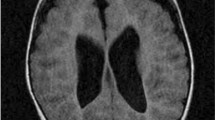Abstract
In 126 early treated PKU patients (type I and type II) a close EEG follow up was performed from birth up to 6 years of age. A total of 1465 EEGs were performed before and after onset of dietary treatment and on 11 more subsequent occasions. The composition of the background activity was normal up to 6 years when only a small number of the children (19) showed no dominant alpha activity. The frequency of epileptiform activity of generalised as well as focal type was low in the first 2 years of life, but afterwards slightly enhanced in comparison to normal control groups. Other findings like generalised theta paroxysms or focal slow waves were rarely observed. Under a standardised protein load at 6 months (52 patients) and at 5 years of age (42 patients) a moderate generalised slowing of the background activity but no other abnormalities were noted.
Similar content being viewed by others
References
Behbehani AW (1985) Termination of strict diet therapy in phenylketonuria. A study on EEG sleep patterns and computer spectral analysis. Neuropediatrics 16:92–97
Benninger D, Matthis P, Scheffner D (1984) EEG development of healthy boys and girls. Result of a longitudinal study. Electroencephalogr Clin Neurophysiol 57:1–12
Blaskovics ME, Engel R, Podosin R, Azen DG, Friedman EG (1971) EEG pattern in phenylketonuria under early initiated dietary treatment. Am J Dis Child 135:802–808
Cavazutti GB, Capella L, Nalin A (1980) Longitudinal study of epileptiform EEG patterns in normal children. Epilepsia 21:43–55
Clayton BE, Moncrieff AA, Pampiglione G, Shepherd J (1966) Biochemical and EEG studies in phenylketonuric children during phenylalanine tolerance tests. Arch Dis Child 41:267–272
Creel D, Buehler BA (1982) Pattern evoked potentials in phenylketonuria. Electroencephalogr Clin Neurophysiol 53:220–223
DeGiorgis GF, Antonozzi I, Del Castello PG, Rosano M, Loizzo A (1983) EEG as a possible prognostic tool in phenylketonuria. Electroencephalogr Clin Neurophysiol 55:60–68
Donker DNJ, Reits D, Van Sprang FJ, Storm von Leeuwen W, Wadman SK (1979) Computer analysis of the EEG as an aid in the evaluation of dietetic treatment in phenylketonuria. Electroencephalogr Clin Neurolphysiol 46:205–213
Eeg-Olofson O (1979) The development of the electroencephalogram in normal children and adolescents from the age of 1 through 21 years. Acta Paediatr Scand [Suppl] 208:1–46
Eeg-Olofson O, Petersen I, Sellden U (1971) The development of the electroencephalogram in normal children from the age of 1 through 15 years. Paroxysmal activity. Neuropädiatrie 2:375–379
Fukushima Y, Kawaguchi S (1973) A study of EEG-abnormalities in normal children. Folia Psychiatrica et Neurologica Japonica 2:105–115
Gross HP, Berlow S, Schuett VE, Fariello RG (1981) EEG in phenylketonuria. Attempt to establish clinical importance of EEG changes. Arch Neurol 38:122–126
Haag C, Benninger C, Lipinski C, Scheffner D (1982) Die EEG-Entwicklung im Kindesalter. Ergebnisse einer Längsschnittstudie bei gesunden Kindern im Alter von 3–16 Jahren. In: Jacobi G (ed) Aktuelle Neuropädiatrie IV. Thieme, Stuttgart, pp 242–245
Klepel H, Rabending G, Wetzel W (1973) Ergebnisse einer elektroenzephalographischen Querschnittsuntersuchung 4–14-jähriger gesunder Kinder. Psychiat Neurol Med Psychol 25: 624–630
Knox WE (1972) Phenylketonuria. In: Stanbury JB, Wyngarden JB, Frederiksen DS (eds) The metabolic basis of inherited disease, 3rd edn. McGraw Hill, New York, pp 266–295
Korinthenberg R, Ulrich K, Füllenkemper F (1988) Evoked potentials and electroencephalography in adolescents with phenylketonuria. Neuropediatrics 19:175–178
Krause W, Epstein C, Averbook A, Dembure P, Elsas L (1986) Phenylalanine alters the mean power frequency of electroencephalograms and plasma L-DOPA in treated patients with phenylketonuria. Pediatr Res 20:112–116
Landi A, Ducati A, Villani R, Longhi R, Riva E, Rodocanachi C, Giovannini M (1987) Pattern-reversal visual evoked potentials in phenylketonuric children. Childs Nerv Syst 3:278–281
Loesch D (1965) The electroencephalogram in phenylketonuria. Electroencephalogr Clin Neurophysiol 18:716
Lütcke A (1971) Clinical picture of phenylketonuria. Encephalographic findings. In: Bickel H, Hudson FP, Woolf O (eds) Phenylketonuria. Thieme, Stuttgart, pp 40–46
Lütcke A, Bickel H (1968) Hirnelektrische Untersuchungen bei der Phenylketonurie. Monatsschr Kinderheilkd 116:301–304
Matthis P, Scheffner D, Benninger C, Lipinski C, Stolzis L (1980) Changes in the background of the EEG according to age. Electroencephalogr Clin Neurophysiol 49:626–635
Moussalli-Salefranque F, Mises J, Cheynel A, Phelippeau M, Saudubray JM (1978) Aspects Evoluties de L'EEG dans les Hyperphenylalaninemies. Rev Electroencephalogr Neurophysiol 8:45–53
Pampiglione G (1968) Some inborn metabolic disorders affecting cerebral electrogenesis. In: Holt KS, Coffey VP (eds) Some recent advances in inborn errors of metabolism. Livingstone Ltd. Edinburgh, pp 80–98
Pedersen HE, Birket-Smith E (1974) Neurological abnormalities in phenylketonuria. Acta Neurol Scand 50:589–598
Pietz P, Benninger C, Schmidt H, Scheffner D, Bickel H (1988) Long-term development of intelligence (IQ) and EEG in 34 children with phenylketonuria treated early. Eur J Pediatr 147: 361–367
Poley JR, Dumermuth G (1968) EEG-Findings in patients with phenylketonuria before and during treatment with a low phenylalanine diet and in patients with some other inborn errors of amino acid metabolism. In: Holt KS, Coffey VP (eds) Some recent advances in inborn errors of metabolism. Livingstone, Edinburgh, pp 61–79
Rolle-Daya H, Pueschel SM, Lombroso CT (1975) Encephalographic findings in children with phenylketonuria. Am J Dis Child 129:896–900
Scheffner D, Lipinski C, Holm C, Schmidt H, Matthis P (1978) Elektroenzephalographische Befunde bei frühbehandelten Kindern mit Phenylketonurie 4 bis 10 Jahre nach Therapiebeginn. Monatsschr Kinderheilkd 126:375–378
Schulte FJ, Kaiser HJ, Engelbart S, Bell EF, Castell R, Lenhard HG (1973) Sleep patterns in hyperphenylalaninemia. A lesson on serotonin to be learned from phenylketonuria. Pediatr Res 7: 588–599
Stadler H (1961) Über das EEG bei der Phenylketonurie. Ann Pediatr 197:429–451
Storm van Leeuwen W, Donker DNJ, Sprang FJ van (1975) The electroencephalogram in inborn errors of metabolism. In: Brazier MAB (ed) Growth and development of the brain. Raven Press, New York, pp 275–286
Wässer S, Theile H (1979) EEG-Kontrollen im Rahmen der Betreuung von Patienten mit Anomalien des Phenylalanin-Stoffwechsels. Acta Paediatr Acad Sci Hung 20:297–313
Author information
Authors and Affiliations
Rights and permissions
About this article
Cite this article
Pietz, J., Lütcke, A., Sontheimer, D. et al. EEG development in early treated PKU patients from birth to 6 years of age. Eur J Pediatr 149 (Suppl 1), 28–33 (1990). https://doi.org/10.1007/BF02126296
Issue Date:
DOI: https://doi.org/10.1007/BF02126296




